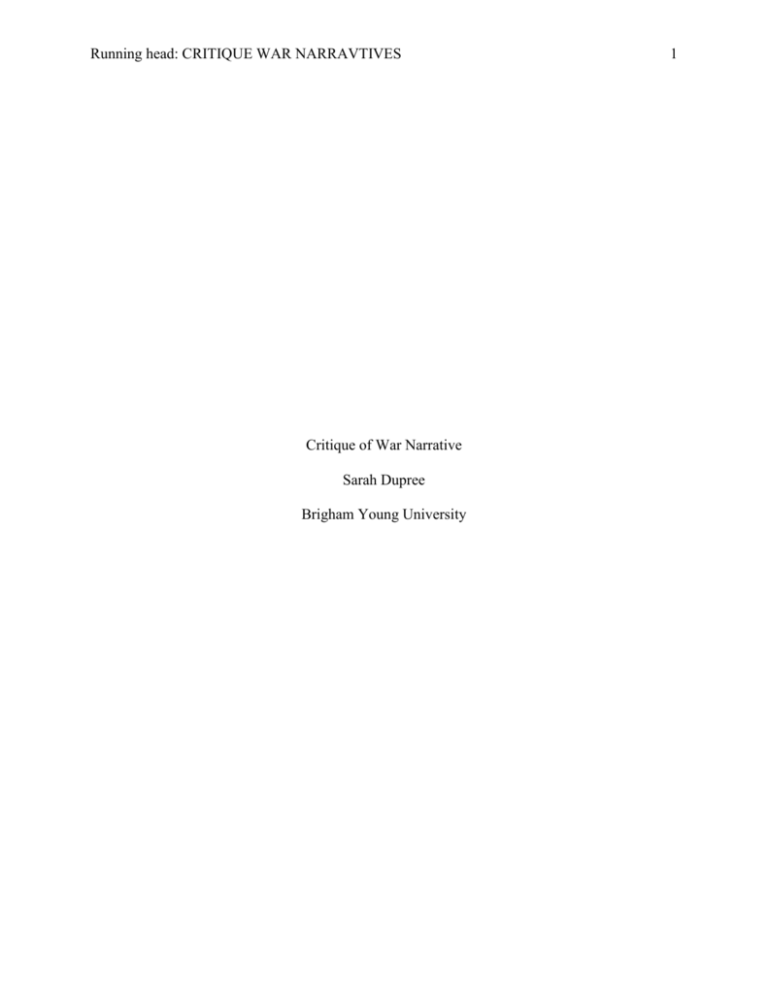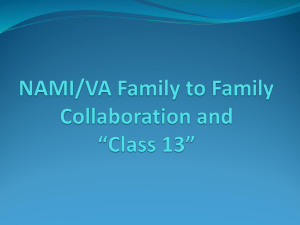War Narrative
advertisement

Running head: CRITIQUE WAR NARRAVTIVES Critique of War Narrative Sarah Dupree Brigham Young University 1 CRITIQUE WAR NARRATIVES 2 Critique of War Narratives War Narratives is a study of letters from veterans with PTSD. In this critique I will summarize the research, point out the strengths and weaknesses of the article, discuss the future applications of this study, and share my thoughts and questions on the study. Summary The study was an analysis of 67 letters from veterans as they concluded their participation in a therapeutic fly-fishing program in Dutch John, Utah along the Green River. Each trip consisted of six veterans who participated in fly-fishing for two days with a professional guide. Each veteran had PTSD. PTSD is described as a person witnessing or experiencing a traumatic event. The person would have the symptoms of re-experiencing, hyperarousal, and avoidance/emotional numbing. The study had veterans from each branch of the armed forces (except the coast guard) from Operation New Dawn, Operation Iraqi Freedom, Operation Enduring Freedom, Operation Desert Storm, Operation Desert Shield, and Vietnam. The letters were written from the veterans to the sponsors of the trips. Each letter was read three times before they were analyzed to ensure that content, sequence, and handwriting was understood. The letters were analyzed based on Explication [what do the letters say?], Explanation [how do the letters say what they say?], and Exploration [what is the reaction/response of the letters to readers?] (Mowatt, & Bennett, 2011). Strengths The analysis of the letters allows the researchers to also compare the wars themselves. They were able to see the different experiences ranging from the Vietnam War all the way up to Operation New Dawn. This allows the researchers to see the progression of PTSD through the CRITIQUE WAR NARRATIVES 3 years. I also think it would be interesting to compare the amount of participants from earlier wars to later wars. Veterans either voluntarily sought out the program or were recommended by another veteran or a VA hospital. No one forced the veterans to participate in the therapy thus the veterans were probably more willing to share and progress. The specifics of the veteran’s branch, war, location, or age did not seem to be important or basis for whom they interacted with. Some seemed to be more drawn to those with PTSD but it wasn’t a defining factor. Participation in recreational activity enhanced the line of communication rather just sitting around in a circle discussing their problems. By focusing on something else and allowing the communication to come naturally they were able to discuss more. This way the entire focus wasn’t on their problems, but it was mainly on catching fish. The combination of nature and physical activity seem to be the most important experience in allowing them to heal and progress. The process of writing letters is more preferred than taking a survey because surveys can be limiting in their answers and don’t provide a lot of room for details where as letters allow the writer to relive the experience. The content of the letters were unstructured so that what was on the minds of the veterans could flow freely. Weaknesses SSRI’s were used to help treat veterans with PTSD but their worst side effect is thoughts or attempts of suicide. However veterans with PTSD were already four times more likely to commit suicide and more troops in 2009 committed suicide than were killed in Iraq and Afghanistan combined. CRITIQUE WAR NARRATIVES 4 There is a lack of gender, gay, or racially-based narratives. Most of the participants were straight, white, males. Uses/Applications SSRI’s (selective serotonin reuptake inhibitors) are antidepressants used for veterans with PTSD. They helped veterans feel less worried and sad by raising the level of serotonin being absorbed by the brain. They have several side effects including upset stomach, diarrhea, appetite suppression, feeling anxious, problems sleeping and/or headaches. They tried to improve quality of life by rediscovering a purpose in life, improving interpersonal relationships, achieving success, easing the transition into civilian life, improving functional ability, and progressing toward recovery. During the analysis four distinct themes emerged: the necessity of comrade while undergoing treatment, the ongoing presence of regret, the process of reflection in reconciling memory, and the benefits of outdoor recreational activity participation. PTSD treatment is a highly personal and human endeavor that cannot be overlooked in the practice of health care. Also requires lots of participation on the client end with them actually wanting to heal, not just expecting a drug to do it for them. Personal/ Interesting Physical and psychological trauma facing returning vets and enlisted personnel between deployments is increasing because military equipment is allowing more people to actually survive the more recent wars than in previous wars. PTSD was not recognized as an official diagnosis until 1980. Before then people were considered cowardly or weak. Even today only about half of the soldiers that actually experience PTSD seek professional treatment. CRITIQUE WAR NARRATIVES 5 References Mowatt, R & Bennett, J (2011). War narratives. Therapeutic Recreation Journal, 45 (4), 286308.





